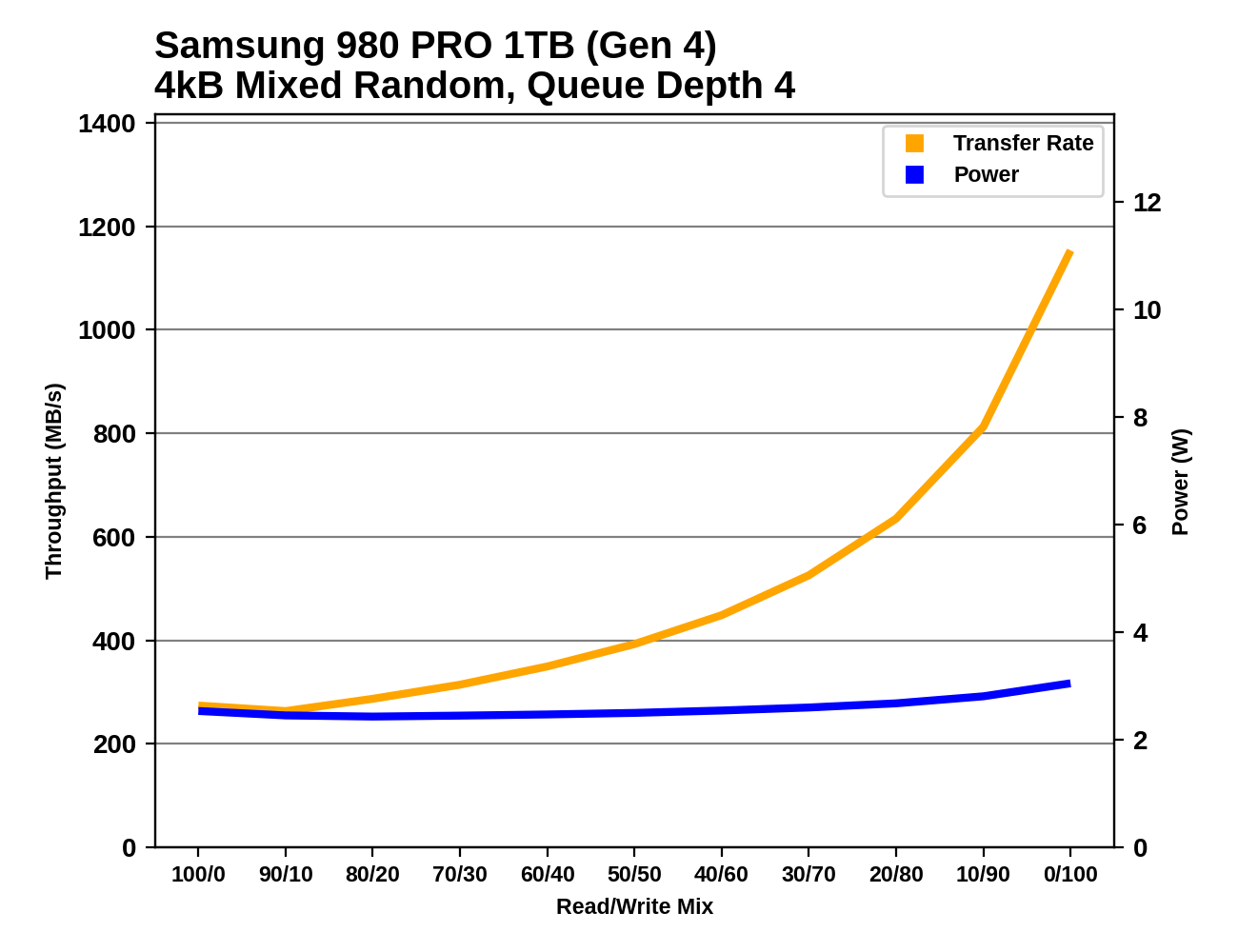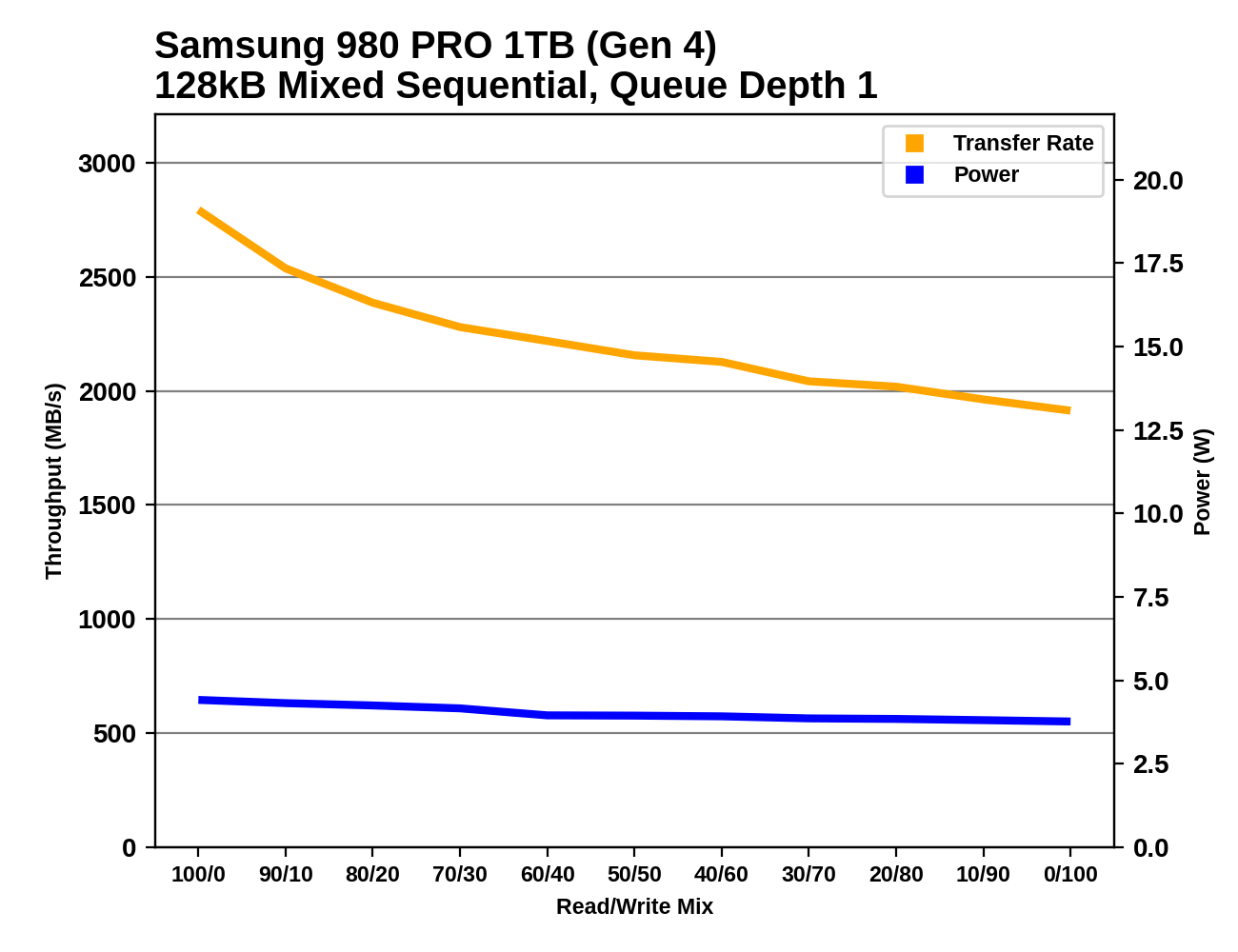The Samsung 980 PRO PCIe 4.0 SSD Review: A Spirit of Hope
by Billy Tallis on September 22, 2020 11:20 AM ESTNote: All our previous testing has been on an Intel test bed. Because of the move to PCIe 4.0, we have upgraded to Ryzen. Devices tested under Ryzen in time for this review are identified in the charts.
Mixed Random Performance
Our test of mixed random reads and writes covers mixes varying from pure reads to pure writes at 10% increments. Each mix is tested for up to 1 minute or 32GB of data transferred. The test is conducted with a queue depth of 4, and is limited to a 64GB span of the drive. In between each mix, the drive is given idle time of up to one minute so that the overall duty cycle is 50%.

Since our mixed random IO test uses a moderate queue depth of 4, the PCIe Gen4 drives don't get much chance to flex their muscle. The overall scores are still generally bound by NAND flash latency, which doesn't vary too widely between current generation drives. There's also a small performance boost when running this test on our newer, faster Ryzen testbed. The Samsung 980 PRO is clearly an improvement over its predecessors, but is merely tied for first place among flash-based drives with the SK hynix Gold P31.
 |
|||||||||
| Power Efficiency in MB/s/W | Average Power in W | ||||||||
Both capacities of the 980 PRO turn in good efficiency scores for the mixed random IO test, substantially improving on Samsung's previously mediocre standing. The 1TB 980 PRO's efficiency is second only to the SK hynix Gold P31. The 980 PROs are a bit more efficient running at PCIe Gen3 speeds than on the Gen4 platform, despite the ~10% performance boost on the faster system.
 |
|||||||||
There are no real surprises in the performance profiles of the 980 PROs. Both capacities show the same general behavior as earlier Samsung drives, albeit with small improvements to performance and power consumption across the board.
Mixed Sequential Performance
Our test of mixed sequential reads and writes differs from the mixed random I/O test by performing 128kB sequential accesses rather than 4kB accesses at random locations, and the sequential test is conducted at queue depth 1. The range of mixes tested is the same, and the timing and limits on data transfers are also the same as above.

The Samsung 980 PROs take the top spots for our mixed sequential IO test, with even the 250GB 980 PRO edging out the 1TB Seagate FireCuda 520. Even when limited to PCIe Gen3, the 980s are a clear step up in performance from eariler high-end drives. The improvement for the 250GB model is the most impressive, since the 250GB 970 EVO Plus is significantly slower than most of the 1TB drives.
 |
|||||||||
| Power Efficiency in MB/s/W | Average Power in W | ||||||||
The 980 PROs turn in more good power efficiency numbers that place them clearly ahead of everything other than the SK hynix Gold P31. And this time, the P31's efficiency lead relatively small at no more than about 25%.
 |
|||||||||
The 980 PROs show a drastically different performance profile compared to earlier Samsung drives. The 970s tend to bottom out during the write-heavy half of the test and recover some performance toward the end. Now with the 980 PRO, performance in the write-heavy half doesn't drop precipitously, so we see a steady decline that most closely resembles how the Intel Optane SSD handles this test










137 Comments
View All Comments
Tomatotech - Tuesday, September 22, 2020 - link
NAND has a long way to go yet. It took a while for SATA SSDs to take off then they were bumping at the top of the SATA bandwidth for many years. Now the PCIe NVME drives are shooting up in data transfer speeds faster than the PCIe committee can bring out new speeds. NVME drives were all clustered at the top of PCIe 3.0 for a few years; PCIe 4.0 has only just come out and already much of the new headroom has gone. At this point the main bottlenecks are the drive controller chips and the PCIe standards themselves. 5.0 is being rushed out for a reason and it isn’t for GPU cards.MFinn3333 - Wednesday, September 23, 2020 - link
Modern SSD's endurance being small is mostly a myth. The last test I saw was on a Crucial BX500 120GB and it wrote 1.2PB on it before it gave out while a smaller 32GB hit around 250TB. The amount of voltage hitting the cells has dropped significantly over the years when they switched to Charged Trap Flash.The 600TBW is the minimum the drive will write.
Pinn - Tuesday, September 22, 2020 - link
Curious about cooling. It looks bare but not near a GPU? Did you see thermal throttling?Billy Tallis - Tuesday, September 22, 2020 - link
The most recent SMART log for the 1TB 980 PRO indicates that it has spent about two minutes at or above the warning temperature (82C) but hasn't hit the critical temperature (85C). And that's out of about 14 power-on hours of testing. The SMART logs for the 250GB drive indicate that it has not hit its warning temperature.back2future - Tuesday, September 22, 2020 - link
What's the cells endurance and storage data stability compared at DWPD=0.3 on these high temperatures (179F, 82C) with long term comparison? What to expect on 5 year professional (high throughput) usage patterns?Oxford Guy - Tuesday, September 22, 2020 - link
“Samsung is abandoning the use of the two bit per cell (MLC) memory that has been the hallmark of the PRO product lines, and with the 980 PRO, Samsung is finally switching to three bit per cell (TLC) NAND flash memory.Along with switching to TLC NAND, Samsung has cut the write endurance ratings in half to 0.3 DWPD and dropped the usable capacities down to the typical TLC/EVO levels of 250/500/1000 GB instead of 256/512/1024 GB. TLC means the 980 PRO now relies on SLC caching for its peak write speeds, and write performance will drop substantially if the SLC cache is ever filled.”
Finally!
What consumers hope for: Worse endurance and worse performance. Higher profits for the company selling it.
Notmyusualid - Tuesday, October 6, 2020 - link
@ Oxford - pretty much sums it up for me.Whiteknight2020 - Tuesday, September 22, 2020 - link
"Pro" means precisely and exactly, absolutely 0% of sod all. And always has. Either a product fits ones particular use case or it does not. I'm a "pro", in that I design, integrate an build Telco grade data centre systems deployments. I don't have a use for 600TBW to a 1TB drive, I'll never write that in it's useful life. I don't have a use for 6GB/s transfer rates. I do have a use for multiterabyte ssds at reasonable (1GB/s) transfer rates. For me, that would be a "pro" drive. For other workloads an entirely different "pro" profile is needed. There are few blanket use cases, except perhaps standard consumer laptop drives.Oxford Guy - Tuesday, September 22, 2020 - link
"'Pro' means precisely and exactly, absolutely 0% of sod all."You're correct and you're incorrect.
You're correct in the sense that Samsung has rendered "Pro" no longer compelling by selling inferior TLC NAND in this product, undermining the established reputation of its Pro-labeled product line.
You're incorrect in terms of this:
"And always has."
This is objectively flatly false. Samsung's Pro-labeled products have existed in the market for quite some time. They have an established reputation for targeting a specific level of performance and having other characteristics, like high-endurance MLC NAND.
Tomatotech - Wednesday, September 23, 2020 - link
See the StoragePro review. This drive has some fantastic numbers under enterprise workloads.For home use? I’m not so sure about the value there. There’s a reason it’s called Pro.
https://www.storagereview.com/review/samsung-980-p...